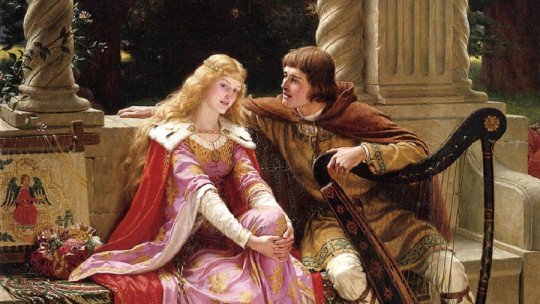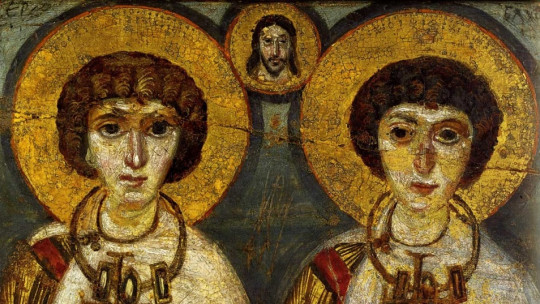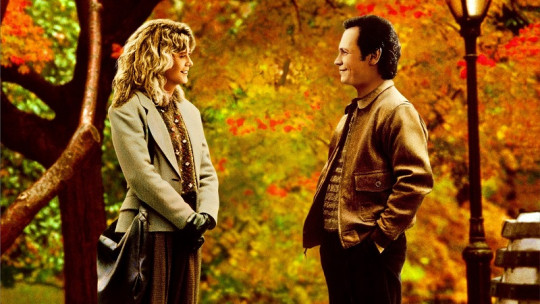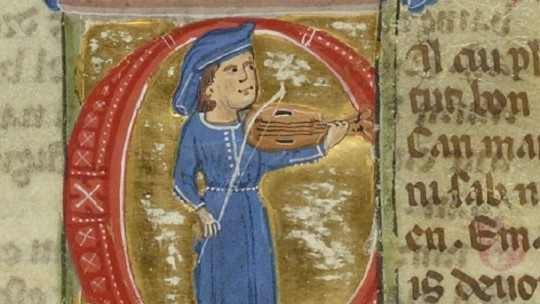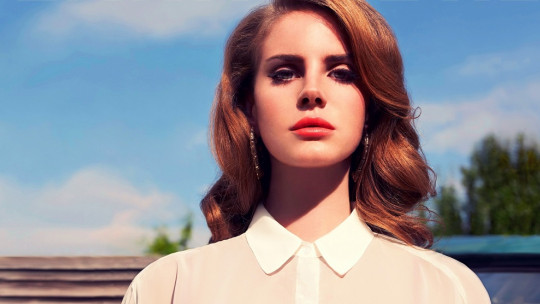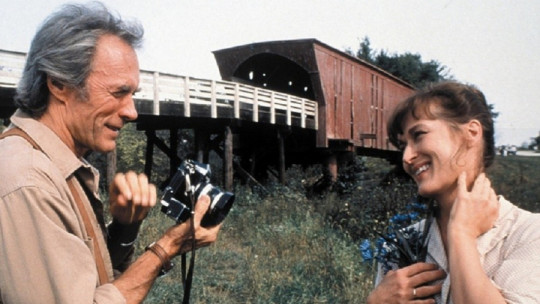Currently, it is quite fashionable to talk about “romantic love”, which has acquired a somewhat pejorative connotation in recent times. Although, in principle, and from a scientific perspective, the idea corresponds to the attraction, emotions and feelings that unite two people and that have a lot to do with biology and psychology, in many circles this term is used to talk about the cultural beliefs that lead to creating toxic or unhealthy love relationships. And, although in a certain way this is the case, reducing the concept of romantic love to that implies leaving aside a series of equally important factors.
It is not our intention to write an article about the pros and cons of so-called “romantic love.” In fact, and as we indicated in the title, our intention is to approach the concept rather from a historical perspective. Specific, examine whether romantic love as such existed in the Middle Ages or if, on the contrary, the idea is the fruit of a later society and culture. To analyze this, we must first briefly comment on what exactly “romantic” means and what the original meaning of the word is. Let’s see it.
Romantic love in the Middle Ages: an anachronism?
To begin with, etymologically, “romantic” comes from Romanticisma cultural and thought current that, from the end of the 18th century and until the first decades of the 19th century, set its sights on human emotions and ideals The movement was a reaction to the prevailing classicism and the Enlightenment, whose precepts “constricted” the artist and human beings in general and inhibited the natural flow of their natural emotions.
In this context, love began to be seen as a path of sublimation, a kind of catharsis of purification of the soul. The romantic artist was obsessed with the transcendent; For him, the world made no sense without the elements that elevated human beings above the mediocrity of everyday life. Love, of course, could not be an exception.
The veneration of the loved one (a veneration that often bordered on the humiliation of the lover), the suffering of love, the obsession with impossible goals… All this perfectly characterizes the idea of love in the romantic era, which Jane Austen, the brilliant British writer, perfectly portrayed in her novel Sense and Sensibilityin which the protagonist, Marianne, suffers tremendously from letting herself be carried away by this type of feeling.
Now, if the concept was born in Romanticism, Can we talk about romantic love in the Middle Ages, or is it an anachronism?
The medieval romance and the “romantic”
The concept, etymologically at least, is closely linked to the Middle Ages. And “romantic” (and its related words, such as Romanticism) comes, according to the most accepted theory, from roman, the name given in medieval times to texts that used languages of Latin origin as a vehicle of expression. That is to say, While scholarly writings continued to be written in Latin, ballads, songs and novels were written in the Romance language
The Romance languages were those that had their roots in Latin. This idea gave rise to many other words, such as “Romanesque”, which described the buildings erected at the time of consolidation of these Romance languages, although this is another topic. In the case at hand, it referred to literature written in the vernacular language of the place, whether Spanish, French, Occitan, Catalan or any other language related to the original Latin stem.
It was logical, on the other hand, that romance literature (li romanz, it began to be called in the 12th century in France) was written in languages vulgar or vernacular, since, unlike scholarly texts, it was intended for the aristocratic class, while the other texts were written and read by clerics. These romances usually included fantastic themes, sprinkled with the characteristic medieval courtly love. This may be one of the reasons why, later, at the height of Romanticism, the new artists began to be called “romantic”, since they also gave importance to elements that escaped the surrounding realism.
On the other hand, we must not forget that artists and other romantic intellectuals felt a special attachment to the Middle Ages (conveniently idealized, of course), which once again connects the romantic sentiment of the 19th century with medieval romances.
The lady, the troubadour and the knight
OK; Up to this point we have seen what relationship we can establish between the word “romantic” and its origin, which has its roots in the Middle Ages and the origins of the Romance languages. But, etymologies aside, did romantic love exist in medieval culture? Let’s see what one of the most prestigious medievalists of the 20th century, George Duby (1919-1996), says about it.
In one of his essays on love in medieval times (see bibliography), Duby briefly describes the basic scheme of which the concept of medieval courtly love is made up. On the one hand, we would have the lady (whose name comes from the Latin dominates, lady), invariably married, whose beauty awakens the greed (sexual, but also for power and the desire for sublimation) of a young bachelor, who most of the time is precisely the vassal of the lady’s husband. From then on, a game of flirting and conquest is established, in which the lady gradually “surrenders” herself, at the pace that she herself imposes.
Duby sees in this behavior a clear feminine “empowerment” (if this expression can be used for the Middle Ages), since it is the lady, and not her suitor, who sets the guidelines for courtship and conquest, without forgetting that She is also the one who marks the end of the relationship, at the time and in the way she wishes.
In any case, The scheme of courtly love that began to be consolidated in the 12th century coincides fully with the explosion of romance literature and, therefore, of chivalric novels which clearly outline some values and behaviors that gentlemen must follow.
In another essay collected in the same volume, in this case by Arnold Hauser (1892-1978), the author raises the idea that the birth of this medieval courtly love is closely related to the rebirth of cities and the rise of commerce, which led to a refinement in the tastes of the wealthy classes and, therefore, the birth of a new ideal in relation to love, which was manifested in a concrete and novel lyric: the poems and songs of the troubadours
The sublime love
New? Depends. The lyric of the beloved singing to the beloved already existed in ancient times. If we take, for example, the Song of songs biblical, we will find beautiful verses about it. Likewise in Ancient Egypt and in its compilations of love songs, where the beloved speaks of the physical virtues of his beloved.
In any case, and despite not being a totally new theme in history, it is true that medieval courtly love has an undoubted trail in the European culture of the following centuries, especially in the Romanticism of the 19th century. The idea of the absolute adoration of the desired woman and the humiliation that the lover is willing to go through to get her attention is closely linked to the ideal of love of the later romantic movement. The link is very clear if we observe the terminology in which the troubadours expressed themselves: this type of love was called Fin’amor, sublime love.
So, The lady stands as an object of veneration, and everything about her is perfect Courtly love is an absolutely idealized love, in no way real, since it is based on the image that the troubadour has of the beloved woman. In some cases, as happens with the famous troubadour Jaufré Raudel (12th century), the song is addressed to a lady whom the lover does not even know (the Countess of Tripoli), but before the image of which, taken from narratives and legends, has fallen hopelessly exhausted.
Marriage and love, two different realities
The idea of unions for love is relatively recent. The marriage union has always been a contract between interested parties, closer to a commercial bond than an emotional one. In the case of Christian Europe, it was a marriage intended exclusively for procreation or, in the “worst” of cases, to prevent the couple from satisfying their sexual appetites in another, less “sacred” context. It is evident, therefore, that the idea of love was not included in the covenant.
As Hauser maintains in his work already cited, The Church itself clearly distinguished the affection that the spouses professed for each other (the dilectio Latin), much closer to respect and consideration, of love It was understood that this second feeling was not linked to the marriage sacrament, since it had more to do with desires and revolutions (both physical and emotional) that the Church advised to control.
Courtly love, therefore, represented a true escape for medieval society. In a world in which marriage represented a contract between lineages, polite dialectic became a delightful game to which gentlemen and ladies indulged with special pleasure. It is important to note that the Church tolerated courtly love to a certain extent, as long as it remained relegated to the “sublime” realm and did not involve carnal contact.
Conclusions
Before finishing the article, let’s briefly summarize what we have stated in it. On the one hand, we have that the word “romantic”, linked to the Romanticism movement, comes etymologically from medieval roman and romance, and that its connection may come from the interest of romantic artists in the medieval past, especially in chivalric deeds. and refined courtly love.
Second, we have observed the similarity between this courtly love and the concept of love in Romanticism: the unrestrained adoration and idealization of the beloved subject, which inevitably entails pain and frustration. We have also commented that, just as romantic love was clothed in sublimation, so did Fin’amor, sublime love, in which ideal veneration took precedence over carnal contact.
So, can we say that romantic love existed in the Middle Ages? Well yes and no. Yes, because there is an obvious parallel between the romantic love of the 19th century, whose reverberations continue in the world today, and medieval courtly love. No, because, despite this, they are two very different worlds with two very different contexts.
While courtly love arose from the interest of the aristocracy to vindicate themselves in a world where the bourgeois class was on the rise, the romantic love of the 18th and 19th centuries arose as a protest against the ideas of the Enlightenment and classicism, in an attempt to give free rein to the subjective self of the artist. On the other hand, the situation of the concept of “romantic love” today cannot be compared to that of Romanticism.
Our values are very different from those that promoted the emergence of the romantic movement, so it is legitimate for today’s society to rethink this type of models, which were born a long time ago, in a very different social context.

